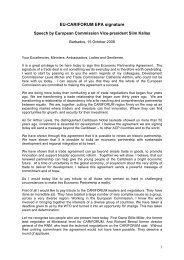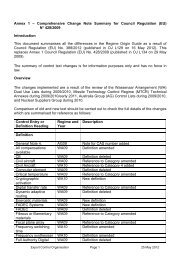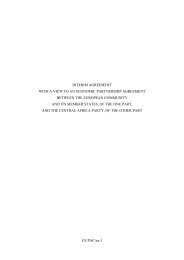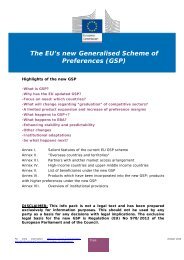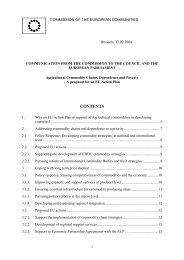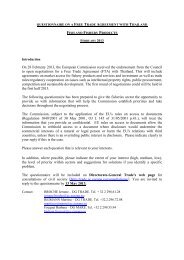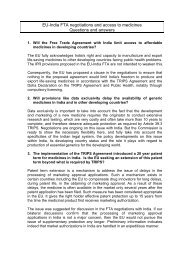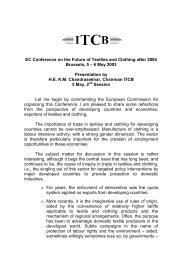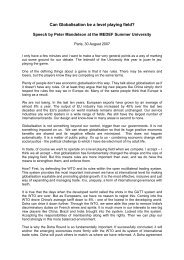Report on the Implementation of the derogation to ... - Trade Websites
Report on the Implementation of the derogation to ... - Trade Websites
Report on the Implementation of the derogation to ... - Trade Websites
You also want an ePaper? Increase the reach of your titles
YUMPU automatically turns print PDFs into web optimized ePapers that Google loves.
Final <str<strong>on</strong>g>Report</str<strong>on</strong>g><br />
RoO Derogati<strong>on</strong> under <strong>the</strong> PACP-IEPA<br />
Several Spanish firms own subsidiary loin processing facilities in Latin American GSP+ countries and<br />
rely <strong>on</strong> this arrangement for <strong>the</strong>ir import <strong>of</strong> loins (i.e. Calvo, Jealsa, Garavilla, Salica; see Table 6.9<br />
below). Some even also use <strong>the</strong>se processing facilities <strong>to</strong> produce canned tuna for <strong>the</strong> EU market<br />
(i.e. Garavilla, Salica). However, in 2010, Spain-based processors faced a decline in locally-landed<br />
whole round tuna, with a reported 40% drop in supply at <strong>the</strong> main ports <strong>of</strong> Galicia. 261 If this trend<br />
c<strong>on</strong>tinues <strong>the</strong> import <strong>of</strong> loins will become all <strong>the</strong> more important in future, at least for skipjack. This<br />
may mean that, unless an alternative steady source <strong>of</strong> duty-free supply can be secured from IEPA<br />
and/ or GSP+ countries, <strong>the</strong> ‘loin quota’ will require expansi<strong>on</strong> when renegotiated in 2012.<br />
Figure 6.4 EU27 producti<strong>on</strong> <strong>of</strong> prepared or preserved tuna, 1976-2008<br />
300,000<br />
250,000<br />
200,000<br />
T<strong>on</strong>nes<br />
150,000<br />
Spain<br />
100,000<br />
Italy<br />
50,000<br />
France<br />
0<br />
Portugal<br />
Source: FAO Fish StatJ (accessed 19 Oc<strong>to</strong>ber 2011)<br />
Aside from supplying domestic markets, EU-based processors export <strong>to</strong> o<strong>the</strong>r EU markets. 262 As is<br />
clear from Table 6.4, Spain is again <strong>the</strong> most important player here. Its intra-EU trade in canned tuna<br />
was worth € 355 milli<strong>on</strong> in 2010. France’s intra-EU exports have declined rapidly over <strong>the</strong> last<br />
decade, while Italy’s and Portugal’s have stagnated (Table 6.4). In fact, Spain’s principal intra-EU<br />
export markets are also <strong>the</strong> main EU-based processors: Italy, France and Portugal (see Table 6.11<br />
below). In o<strong>the</strong>r words, increased Spanish producti<strong>on</strong> appears <strong>to</strong> have displaced producti<strong>on</strong> in o<strong>the</strong>r<br />
EU member states.<br />
261 Murias 2011b.<br />
262 See Secti<strong>on</strong> 6.7.3 for exports by destinati<strong>on</strong> and a discussi<strong>on</strong> <strong>on</strong> possible trade diversi<strong>on</strong> generated by<br />
PNG’s derogati<strong>on</strong>.<br />
Linpico s.a.r.l. Page 130




